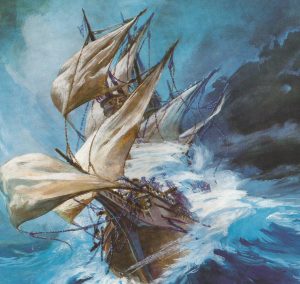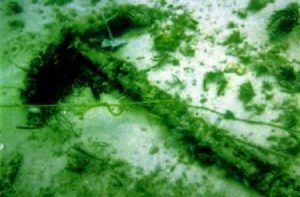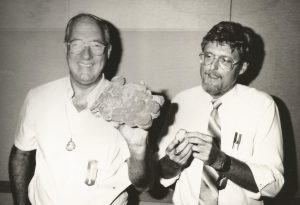Juno Beach Galleon Embroiled in Permit Battle

Is the Juno Beach wreck the “last galleon”?
When Nelson Waite, a commercial diver searching for fish and lobsters off Juno Beach, Florida, discovered what was later identified as one of the oldest Spanish wrecks in our waters, he wasn’t too impressed. In fact, he thought the artifact—an anchor with a 12-foot shank and large flukes—was from a relatively recent vessel. It appeared too elongated and wasn’t extremely covered with marine growth. He gave it one more glance as he glided by on his diver propulsion vehicle, then left and never thought about it until 10 years later.
In 1987, Waite read about the San Miguel de Arcangel, a Spanish treasure ship sunk in 1660 that was found by Jupiter Beach lifeguard Peter Leo while snorkeling during his lunch break. The 10 to 15-foot-deep shallow water discovery was just one mile north of Waite’s 80-foot-deep find, prompting him to return for a closer look. “I didn’t have the luxury of a lot of bottom time like Leo did on the Jupiter wreck,” Waite said, “but it was worth a try when I uncovered pottery shards, ballast rocks, lead sheathing and a large wooden beam similar to those on old Spanish ships.”

Juno Beach Wreck Anchor
The Cleveland, Ohio, native who settled in Florida in 1970, wasted no time telling a friend, Judd Laird, who had the time and money to proceed with the next step. Laird contacted two widely acclaimed maritime authorities: the late Peter Throckmorton—designated “dean of underwater archaeology”—and Duncan Mathewson—the archaeologist who helped find the late Mel Fisher’s treasure galleon, Nuestra Senora de Atocha. Upon examination of the site and artifacts, the experts determined it was from the late 1500s, one of the oldest Spanish wrecks in the western Hemisphere.
Laird called it “the last galleon” when he submitted the claim in his name. Historically, it was the last federal Admiralty claim of a Spanish vessel just before passage of the Abandoned Shipwreck Act (ASA) which gives states all rights to shipwreck salvage within three miles of their shorelines. Admiralty law, sometimes referred to as federal maritime law, favors salvors by giving them more control over their discoveries without the bullying they claim to get from state officials under the ASA. Most salvors scorned the Act from the get-go when it was passed. (See “Federal Versus State Law in Maritime Cases,” Pacific Maritime Magazine, September, 2010). Although the state must adhere to federal guidelines, it still receives 20 per cent of any valued artifacts and remains responsible for issuing the search permit. In essence, it boils down to concurrent federal/state jurisdiction over the search site.

Archaeologist Duncan Mathewson (right) poses with Mel Fisher who holds treasure from Atocha. Mathewson surveyed the Juno Beach wreck site.
Laird named his company TULCO after the ancient capital of the Aztecs. With Waite, he opened JESCO: Juno Educational Shipwreck Conservation Organization, a working lab and small museum in Jupiter. Shea McLean, an archaeologist from Florida State University, who helped in the preservation lab said,” The cooperation between the salvors and the state was outstanding and served as an example for others to follow.” He praised archaeology interns who pieced together hundreds of shards from olive jars.
As time passed, Laird couldn’t afford to continue running JESCO and donated everything to various state museums. Years slipped by until he ran into Lyle Kennedy, CEO of Seafarers Exploration Corp., a salvage firm based in Tampa, Florida. For more than 20 years, Kennedy conducted business through companies that offered securities’ sales, trading and investment banking services. In 2008, he decided to try his luck in search of treasure. He had money to invest and Laird and his last galleon appeared workable. Waite dropped out and Laird joined Kennedy’s Seafarers group, a short-lived union that ended up in court. Seafarers sub-contracted the site from TULCO and Kennedy got the salvage permit from the state of Florida which was good for three years. Laird was displeased with the transaction and fought it, but unfortunately couldn’t follow through. He died in 2013.

Juno Beach Wreck Anchor
At this point, almost 30 years had passed since the discovery of the last galleon, now known as the Juno Beach wreck. Why couldn’t it resurface? (pun intended). In a frustrating attempt to find the answer, this writer spent a week trying to get through to somebody in the state’s archaeology department, Division of Historical Resources, Tallahassee, Florida. Finally, a call from Dr. Mary Glowacki, Bureau of Archaeological Research, disclosed that the permit had expired due to no activity in the area and everything “was now under state stewardship and inactive Admiralty arrest.”
“Not so!” exclaimed Kennedy who responded immediately to my call. “We were magging (metal detecting) it less than a year ago. The state permit expired, but we paid $3,500 to a U.S. Marshal to arrest the site to us in the Admiralty claim.” He says Seafarers was awarded the entire site by a federal judge, but the state was slow to recognize this and put it in their appropriate legal terminology.” Kennedy added, “We follow proper principles and guidelines and have a team of experienced archaeologists working with us.” He likes to call his claim “a lottery ticket that never runs out.”
As the bureaucratic battle continues over jurisdiction, the Juno Beach wreck remains somewhere offshore buried in the sand. Or does it? The debris field hasn’t revealed any significant finds…no cannons, no treasure so far. But two ships of the 1715 Spanish treasure fleet, possibly sunk in the area, have never been found. Is the Juno Beach wreck lost forever or will it ascend from its grave like the mythical Phoenix rose from its ashes? Will the lottery ticket run out or be cashed in? Only time will tell.
9 Comments
Submit a Comment
All Rights Reserved © | National Underwater and Marine Agency
All Rights Reserved © | National Underwater and Marine Agency
Web Design by Floyd Dog Design
Web Design by Floyd Dog Design

This is a great article! It’s wild to think there might be a treasure ship out there waiting to be discovered. I hope the permit is straightened out and the salvage people find the galleon.
Thank you. I appreciate your comments. Yes, there is always the possibility this MIGHT be a treasure ship. I will keep an eye on what’s going on and let you know if the state officials and salvor get things straightened out so that salvage efforts may continue. Cheers, Ellsworth
Surely many wrecks along the coast there were savaged by Indians and the Spanish, we know this. Then possibly by the French and Brits. Some early Spanish explorers here saw gold and silver on Indian people and convinced themselves there was gold and silver in Florida.
What’s the law when you find a shipwreck like that is a yours
The laws are very strict today. The Abandoned Shipwreck Act gives the states rights to vessels up to three miles from the shoreline. Unfortunately, that is where many wrecks are found. State permits are available, but there are certain requirements and restrictions. The state marine archaeologist can give you details on all of this.
This is a great story. I live just a few miles from Juno Beach in Port St Lucie. This is a great area for shipwreck buffs like me.
Is there an update available on this story…have the permits be worked out and has Mr Kennedy’s company been able to start diving or recovering?
I was a Underwater Archeology student that worked on that site for 6 months. I helped set up and maintained the preservation tanks at the museum and I dived the wreck site up to 3 times a day most of the time I was there. It was an incredible experience. Besides the timber, sheathing and cannon balls we found we discovered the ballast they used was partially made up of jadeite, a semiprecious stone that was used to make idols by the the natives of Central and South America. Our theory on why there was no cannons found was that they were jettisoned during a storm to try and save it from foundering and with over 400 years, the depth of the wreck and proximity to the gulf stream made it very difficult to determine a location to search for them. Glad to see there is still interest in it even though no “treasure” has been found.
Brian: Many thanks for sharing your experience with us. You, being a student at the time, were so fortunate to work on such a historical shipwreck. The jadeite being part of the stone ballast is quite interesting.
Keep diving! Cheers, Ellsworth